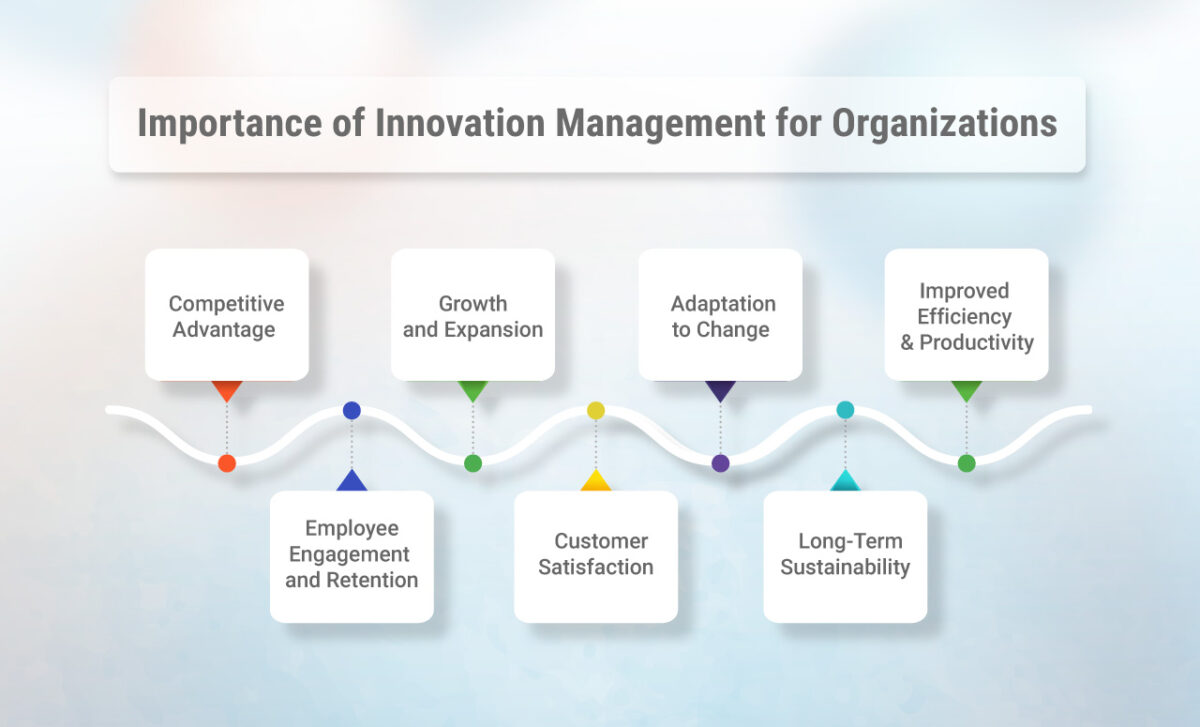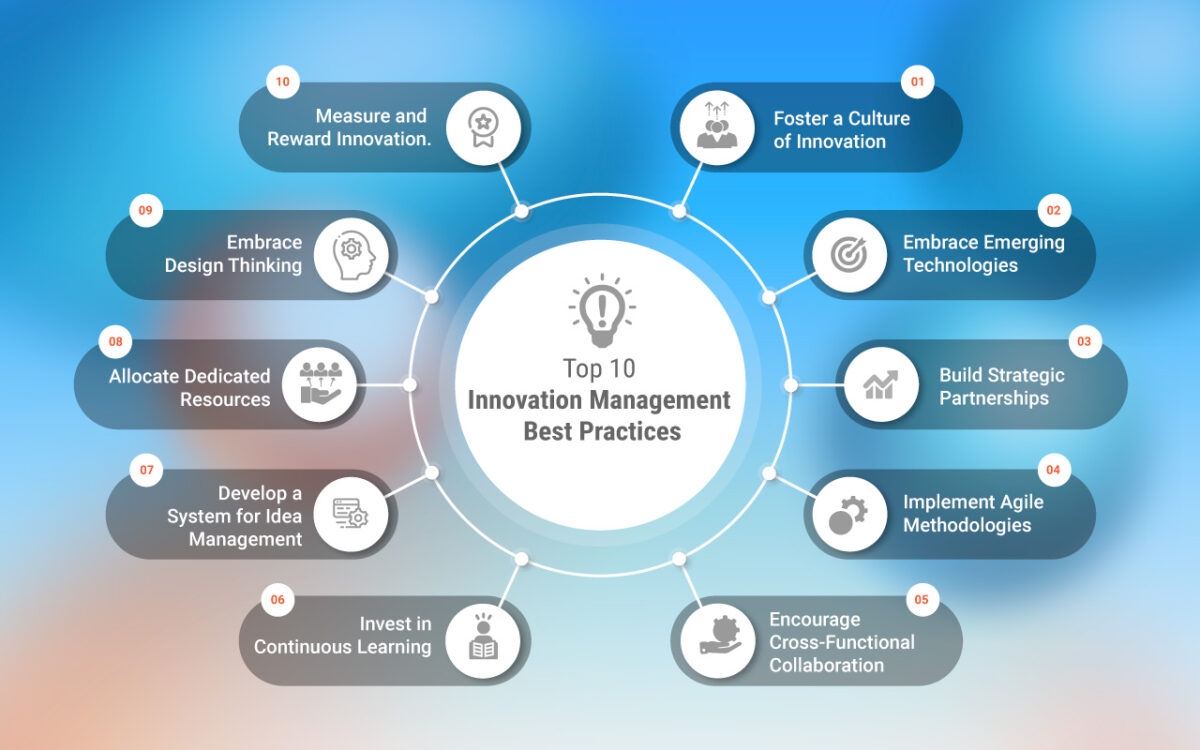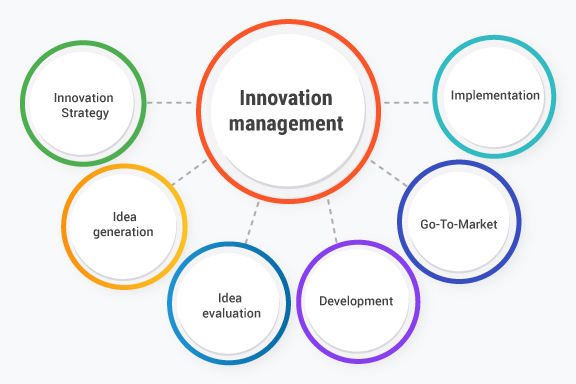What is Innovation Management?
Innovation management is defined as the process of a systematic and strategic approach to generating, developing, and implementing new ideas, products, services, or processes that result in organizational value addition. For businesses, innovation management serves as a key driver of competitive advantage.
It encompasses various activities and stages, including ideation, idea evaluation and selection, development and prototyping, commercialization, and ongoing improvement. It involves creating an environment that encourages and supports innovation, as well as establishing processes and structures to effectively manage and drive innovation initiatives.
Key components of innovation management typically include:
- Innovation Strategy: Innovation Strategy defines the organization’s innovation goals, objectives, and priorities. This includes determining the focus areas for innovation, such as product innovation, process innovation, or business model innovation.
- Idea Generation: Encouraging the generation of new ideas from both internal and external sources. This can involve techniques such as brainstorming sessions, employee suggestion programs, customer feedback, market research, and collaboration with partners or experts.
- Idea Evaluation and Selection: Assessing and selecting the most promising ideas for further development. This involves evaluating the feasibility, market potential, technical requirements, and alignment with strategic goals. Various tools and methods, such as feasibility studies, market research, and business case evaluations, are used to evaluate ideas.
- Development and Prototyping: Transforming selected ideas into tangible prototypes or minimum viable products (MVPs). This stage involves refining the concept, conducting research and development, testing, and iterating to create a viable solution.
- Go-to-Market: Bringing the innovative product, service, or process to the market. This includes activities such as marketing, sales, distribution, and launching the innovation. It also involves considering intellectual property protection, regulatory compliance, and potential partnerships or collaborations.
- Implementation and Adoption: Ensuring successful implementation and adoption of the innovation within the organization. This may involve change management, training, and creating a supportive culture that embraces innovation.
Effective innovation management requires a supportive organizational culture that fosters creativity, risk-taking, and collaboration. It involves engaging employees at all levels, promoting cross-functional teamwork, and providing the necessary resources, tools, and incentives to support innovation initiatives.
Innovation management is crucial for organizations to stay competitive in dynamic and evolving markets. By effectively managing innovation, companies can drive growth, create value, respond to market changes, and meet the evolving needs and expectations of customers.
Importance of Innovation Management for Organizations

Innovation management is of great importance for organizations for several reasons:
1. Competitive Advantage
In today’s rapidly changing business landscape, organizations need to stay ahead of the competition. Innovation management allows companies to develop unique products, services, or processes that differentiate them from competitors. It helps organizations create a sustainable competitive advantage by offering something new and valuable to the market.
2. Growth and Expansion
Innovation is a key driver of growth and expansion. By continually innovating and introducing new products or services, organizations can tap into new markets, attract new customers, and increase their market share. Innovation management enables companies to explore new opportunities, enter new industries, and expand their reach.
3. Adaptation to Change
Innovation management helps organizations adapt to external changes, such as evolving customer preferences, technological advancements, or regulatory shifts. It allows companies to anticipate and respond to market disruptions, industry trends, and emerging challenges. By being proactive and innovative, organizations can navigate uncertainties and stay relevant.
4. Improved Efficiency and Productivity
Innovation management not only focuses on developing new products but also on improving internal processes and operations. It encourages employees to find innovative solutions to streamline workflows, optimize resource allocation, and enhance productivity. Innovation management can lead to cost savings, increased operational efficiency, and improved overall performance.
5. Employee Engagement and Retention
Engaging and retaining talented employees is crucial for organizational success. Innovation management provides employees with opportunities to contribute their ideas, be creative, and make a meaningful impact. It fosters a culture of innovation, continuous learning, and empowerment. Organizations that prioritize innovation management often attract and retain top talent who are motivated by the opportunity to work in a dynamic and innovative environment.
6. Customer Satisfaction
Innovation management helps organizations better understand and address customer needs, preferences, and pain points. By developing innovative solutions, organizations can provide enhanced customer experiences, improved products or services, and increased customer satisfaction. Innovation management enables companies to stay customer-centric and deliver value that meets or exceeds customer expectations.
7. Long-Term Sustainability
Organizations that embrace innovation management are better positioned for long-term sustainability. By continuously innovating and evolving, companies can adapt to changing market dynamics, remain relevant, and avoid stagnation. Innovation management encourages a forward-thinking mindset and a culture of innovation, ensuring that organizations stay resilient and thrive in the long run.
In summary, innovation management is essential for organizations to thrive in a dynamic business environment. It drives growth, fosters competitiveness, enhances efficiency, and enables organizations to meet the evolving needs of customers. By effectively managing innovation, organizations can position themselves for long-term success and create a culture of innovation that permeates throughout the entire organization.
Learn more: What is Business Innovation?
Innovation Management Process: 9 Key Steps
The innovation management process typically involves several steps or stages. While the specific steps may vary depending on the organization and context, here are the common stages involved in the innovation management process:
Step 1. Identify Challenges and Opportunities
The first step is to identify the challenges or opportunities that the organization aims to address through innovation. This could involve analyzing market trends, customer needs, competitive landscape, technological advancements, and internal capabilities. The goal is to gain a clear understanding of the areas where innovation can make a meaningful impact.
Step 2. Idea Generation
In this stage, ideas are generated to address the identified challenges or opportunities. This can be done through brainstorming sessions, idea contests, employee suggestion programs, market research, customer feedback, or collaboration with external partners. The focus is on generating a diverse range of ideas without judgment or evaluation.
Step 3. Idea Screening and Evaluation
Once ideas are generated, they need to be screened and evaluated to identify the most promising ones. This involves assessing ideas based on criteria such as feasibility, market potential, strategic alignment, technical requirements, and resource availability. Various evaluation methods such as SWOT analysis (Strengths, Weaknesses, Opportunities, Threats), scoring models, or expert reviews can be used to evaluate ideas.
Step 4. Concept Development
Once the most promising ideas are selected, they are further developed into concept proposals. This stage involves refining the ideas, conducting market research, creating prototypes, and assessing technical feasibility. The goal is to develop a clear concept that outlines the value proposition, target market, competitive advantage, and key features of the proposed innovation.
Step 5. Business Case Development
A business case is created to assess the viability and potential return on investment of the innovation. This involves conducting a detailed analysis of the market size, potential revenue, cost estimation, financial projections, risks, and benefits. The business case helps decision-makers evaluate whether the innovation aligns with the organization’s strategic goals and if it is worth pursuing.
Step 6. Development and Testing
If the business case is approved, the innovation moves into the development stage. This involves transforming the concept into a tangible product, service, or process. Prototypes or minimum viable products (MVPs) are created and tested to gather customer feedback, validate assumptions, and identify potential improvements. Iterative testing and refinement may be conducted to enhance the innovation.
Step 7. Implementation and Commercialization
Once the innovation is developed and tested, it is prepared for implementation and commercialization. This stage involves finalizing the product design, manufacturing, or development, setting up production processes, establishing supply chains, and creating marketing and sales strategies. Intellectual property protection, regulatory compliance, and partnerships or collaborations may also be considered during this stage.
Step 8. Launch and Post-launch Evaluation
The innovation is officially launched in the market, and marketing and sales efforts are executed. Post-launch evaluation involves monitoring the performance of the innovation, gathering customer feedback, measuring key performance indicators (KPIs), and assessing the success of the innovation in achieving its objectives. Based on the evaluation, improvements or adjustments may be made to enhance the innovation’s performance.
Step 9. Continuous Improvement and Scaling
Innovation management is an iterative process, and organizations need to continuously seek ways to improve and scale their innovations. Lessons learned from the launch and post-launch evaluation are incorporated into the innovation management process. Feedback is gathered from customers, employees, and stakeholders to drive further improvements and inform future innovation initiatives.
It’s important to note that innovation management is not a linear process, and the stages described above may overlap or iterate depending on the specific innovation and organizational context. Flexibility, adaptability, and a willingness to learn from both successes and failures are crucial for effective innovation management.
Learn more: What is Product Innovation?
Top 10 Innovation Management Best Practices for 2023

Innovation management is crucial for organizations to stay competitive and adapt to changing market dynamics. Here are some best practices for innovation management in 2023:
1. Foster a Culture of Innovation: Create an organizational culture of innovation that encourages and rewards innovation. Promote openness, collaboration, and a willingness to take risks. Encourage employees at all levels to contribute ideas and provide them with the necessary resources and support.
2. Embrace Emerging Technologies: Stay updated with the latest technological advancements and explore how they can be leveraged to drive innovation within your organization. Technologies such as artificial intelligence, blockchain, the Internet of Things (IoT), and virtual/augmented reality can open up new opportunities for growth and efficiency.
3. Build Strategic Partnerships: Collaborate with external partners, such as startups, universities, research institutions, and industry experts. These partnerships can bring fresh perspectives, and access to new technologies, and help you tap into a wider network of innovators.
4. Implement Agile Methodologies: Agile methodologies, such as Scrum or Kanban, can enhance innovation management by promoting iterative and flexible approaches to product development. These methodologies enable quick adaptation to changing requirements and customer feedback, resulting in faster innovation cycles.
5. Encourage Cross-Functional Collaboration: Break down silos within your organization and encourage collaboration across departments and teams. Foster interdisciplinary interactions to facilitate knowledge sharing, creative problem-solving, and the cross-pollination of ideas.
6. Invest in Continuous Learning: Promote a learning culture within your organization. Encourage employees to continuously develop their skills and knowledge through training programs, workshops, and conferences. Provide opportunities for employees to experiment, learn from failures, and share their learnings with others.
7. Develop a System for Idea Management: Implement a robust system to capture, evaluate, and prioritize ideas from employees, customers, and other stakeholders. Use a combination of methods such as idea management platforms, suggestion boxes, hackathons, or innovation challenges to gather and evaluate ideas effectively.
8. Allocate Dedicated Resources: Dedicate a budget, time, and personnel specifically for innovation activities. Create dedicated teams or innovation labs that can focus on researching, prototyping, and testing new ideas without distractions from day-to-day operations.
9. Embrace Design Thinking: Apply design thinking principles to identify unmet customer needs and develop innovative solutions. This human-centered approach involves empathizing with users, defining problem statements, generating ideas, prototyping, and testing to create products and services that truly resonate with customers.
10. Measure and Reward Innovation: Establish metrics to track and measure the success of innovation initiatives. Consider metrics such as the number of new ideas generated, successful implementation of ideas, revenue from new products/services, customer satisfaction, and employee engagement. Recognize and reward employees who contribute to the innovation process.
Remember, innovation management is an ongoing process. Continuously reassess and adapt your innovation strategies based on market trends, customer feedback, and internal insights to stay at the forefront of innovation in 2023 and beyond.
Learn more: What is Strategic Innovation?
Why Trust IdeaScale on Innovation Management?
For over 15 years, IdeaScale has empowered organizations worldwide to create and mature their innovation management process. Our platform supports thousands of innovation programs built on best practices aligned with the ISO 56001 standard for Innovation Management Systems—a framework that ensures innovation is strategic, measurable, and integrated across the organization.
With insights from over 25,000 innovation initiatives and feedback from 4.5 million users, IdeaScale delivers real-world guidance and expert-backed strategies that evolve with the demands of today’s business environment.
Our Methodology
This guide reflects our hands-on experience and commitment to excellence in innovation management. It draws from:
- The structured approach of ISO 56001, the international standard for innovation systems
- Data and lessons from global innovation campaigns across industries
- Expert input from certified innovation consultants and practitioners
We don’t just talk about innovation—we help organizations implement and scale it with purpose and precision.
To learn more, dive deeper into our live session: ISO 56001 and How to Start Implementing It in Your Organization
Most Recent Blogs
Explore the latest innovation insights and trends with our recent blog posts.










